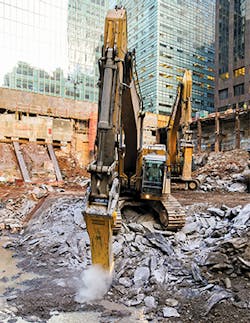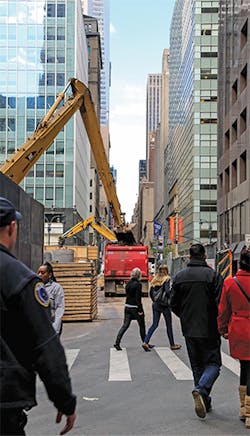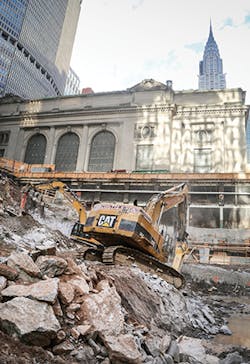“I feel like a conductor,” says Ted Civetta with a grin as he stands amidst the bustle of New York City and watches the seemingly choreographed movements of excavators and breakers in a pit 55 feet below him.
Civetta has earned a reputation as being one of the best foundation guys in the area. His grandfather started the business after emigrating from northern Italy in the 1920s. Now Civetta’s son, Patrick, is the fourth generation to work in the family business, John Civetta & Sons ( www.civetta.com, established in 1971). From a humble start building stone foundations, the company now boasts a resume of some of the largest, most technically challenging foundation projects in New York.
The latest such project for which Civetta is orchestrating the crew, equipment, and materials is a $45 million job that will span 18 months and result in a nearly acre-sized base, for what will be the third tallest building in the United States. And it’s all being done in the middle of the world’s largest central business district.
Station as an excavator fills a truck with rock from
the foundation excavation for One Vanderbilt.
What Goes Up Must First Go Down
Five buildings in midtown Manhattan came down to make way for One Vanderbilt Place. John Civetta & Sons helped wrap up the demolition and then got to work excavating the site, which had its official groundbreaking October 18, 2016.
Madison Avenue runs along the west side of the huge block where Civetta’s crew runs a John Deere 650 excavator, as well as two CAT 365s and a Komatsu 600 armed with Atlas Copco HB 7000 hydraulic breakers ( www.atlascopco.us ). To the east stands Grand Central Station, the historic and iconic hub of New York transportation. Thousands of passengers move in and out of the station daily, with light rail and subway cars traveling in, out, and past the station on 67 tracks, many of which parallel the massive excavation pit and can even be seen through holes that will be future subway entrances to One Vanderbilt. But for now, it’s simply a hole big enough to hold the water from 30 Olympic-sized swimming pools.
“In most parts of the country, you hire an excavator, and then you hire a concrete guy,” says Civetta. “In New York City, you hire a contractor that does both the excavation and the concrete foundation. We create a bathtub, and, once the building is up to street level, we hand it off to another specialty contractor who builds the towers.”
Civetta, 60, moves around the site with the passion and agility of a man half his age. He has a feather attached to his fedora-shaped hardhat—and he’s earned the right to “tuck a feather in his cap,” as the saying goes. In New York, the Civetta name is practically synonymous with large-scale foundation work.
“He’s a professional engineer by trade, and he’s very knowledgeable. When it comes to rock excavation, there aren’t many people better at what he does,” says Frank Caporaso, who owns CAP Rents ( www.caprents.com ) in nearby Astoria, NY.
He’s known Civetta since the early ’80s, when the two family-owned businesses began working together. Civetta trusts Caporaso and his son, Vincent, the third generation of CAP Rents, with his equipment rental needs.
Rock type and hardness differs greatly across each of New York City’s five boroughs, which makes the experience of CAP Rents, a rental business Caporaso’s father started in 1969, necessary to ensure the best equipment is matched to each specific job site.
In the case of One Vanderbilt, the site is laden with mica schist, Manhattan schist, and granite to the rate of 60,000+ PSI, an extremely high capacity rating for rock. By the time Civetta’s team is done, they will have removed 70,000 cubic yards of material, 50,000 cubic yards of which will be rock.
One Vanderbilt Place
Height: 1,401 feet (including antenna spire)
Floors: 57
Square Feet: 1.6 million
Building Cost: $3 billion or more
Anticipated
Rental Income: $1 million per day
Address: One Vanderbilt Ave., New York, NY
Developer: SL Green Realty Corporation
Architect: Kohn Pedersen Fox (KPF)
Groundbreaking: October 2016
Completion: 2020
Work That’s Hard As a Rock
Breaking through that much material—hard material, at that—takes the right tools to ensure productivity and meet deadlines. That correlates directly with profits, too; there’s a major fine for each day Civetta’s crew goes past deadline, but also a hefty bonus for each day they’re ahead.
CAP Rents takes their role in that process seriously, whether it’s recommending the right equipment or being ready at all times to provide onsite service. They work closely with Atlas Copco technicians who come onsite to offer training on operating and servicing hydraulic breakers, compressors, and generators. That ensures the entire CAP Rents team is ready to help with any customer needs.
When Civetta was working on a job on the West Side in April 2016—and dealing with some of the toughest rock he’d ever experienced—Caporaso recommended that Civetta try something new. After visiting with Eudes Defoe, Mid-Atlantic regional channel manager with Atlas Copco, Caporaso was convinced that Atlas Copco’s HB 7000 hydraulic breaker could help Civetta’s productivity in the challenging environment. Defoe had the breaker brought to the site for a trial.
“The HB 7000 breaker weighs the same as the breaker they were using from another manufacturer, but we knew it would offer Teddy significantly more productivity,” says Defoe. “It uses AutoControl, which adjusts the breaker’s output while it’s operating, as well as a technologically advanced nitrogen piston accumulator that ensures consistently high impact energy.”
That performance showed, and Civetta was instantly sold on making the switch. “We find that these hammers hit harder and slower, which we think is better. They handle wear better, too,” he says. “With the other hammer we were using, we got to a point where it wouldn’t take the rock out any more. Then we started hammering with the HB 7000, and all of a sudden we started taking rock again. We know they’re effective, and they have a really great warranty on them. For what we do, it’s a better product. Plus, we have been using Atlas Copco rock drills since I was young.”
The HB 7000 features a 280- to 450-bpm impact rate and can excavate and extract as much as 800,000 pounds of rock in an eight-hour day. This equates to an impressive 3.2 million pounds a day for Civetta’s crew.
“I just don’t know how they’re able to achieve that kind of size to power ratio,” says Caporaso of the breaker.
Civetta credits the hammer’s tool steel for helping with productivity, too. “We find the chisel points on these hammers last longer than anything else,” he says. “The tool steel is incredible—the best in the industry by far. We run these machines 10 hours a day, six days a week, so we really don’t give equipment much of a break.”
An unscheduled break leaves tens of thousands of dollars on the line if it leads to missing a deadline. CAP Rents works closely with Atlas Copco to make sure that doesn’t happen. The partnership ensures parts are ready and will be at the job site as quickly as possible.
In short, “these guys are on it,” says Civetta of the service and support.
All Is Calm at the Site
Beyond fast service and high productivity, the equipment combination is especially well suited to the challenges of construction in the heart of a huge city. “If you see what foundation contractors do and how they work in Manhattan, it’s mind-boggling,” says Caporaso. “You have buildings right next to the site. There are skyscrapers butting up against the site. You can’t under cut. There are tiebacks to reinforce the walls. You’ve got the subway running underground. It’s just incredible the amount of engineering that goes into this work.”
Vibration monitors all around the construction site closely measure and record the effects of the breakers on nearby structures, from the massive amount of utilities running along Madison Avenue to the belowground Metro North parking garage and the retail stores in the lower level of Grand Central. “That’s one of the great things about Atlas Copco breakers today—it’s very difficult to create vibrations with them,” says Civetta.
Atlas Copco’s HB breaker range incorporates a VibroSilenced Plus system that isolates the percussion mechanism and breaker box to reduce noise and vibrations. The breakers also have an EnergyRecovery system that uses the recoil energy to power the next blow, which maximizes power while lowering vibrations.
“I can’t think of a more ideal tool for this type of project,” says Tom Schwind, a business development manager for Atlas Copco. “Between the need to hammer through incredibly hard rock quickly, and yet do so without vibrations that would disturb passersby and businesses, there’s really no other reasonable solution for demolition work in the heart of a city.”
Technology has come a long way since Civetta had to rely on blasts to get through tough rock—using enough to get results, but not too much to cause excessive vibration and noise issues. Now they watch the vibration monitors, and, if it’s getting close to the limits in a sensitive area, they switch to a smaller breaker or, if necessary, to a rock splitter.
Fast Tracking to the Foundation
The equipment combination that CAP Rents provided had Civetta’s team well ahead of schedule on the project after just a month onsite. Civetta set a goal of hauling 200 truckloads of rock out each week to a pit in New Jersey, and he was hitting that goal “like clockwork.”
“Frankly, we got so far ahead with the rock, because the hammers are so good. We really have to catch up around the perimeter doing the support of the excavation,” he says. “One of the most challenging parts of excavation in Manhattan is holding up everything around the site—the buildings, streets, subways—so there is a certain amount of support excavation that we need to do.”
With all of the rock out and the sides braced, Civetta’s team will move to pouring the walls and then the foundation. With roughly 900 feet of wall surrounding what will essentially be three tall basements, each with a separate concrete floor, Civetta says it will take 15 60-foot pours per ring. At three days a pour and 45 pours needed, just that portion will take about six months, which started in early February 2017. With 4,000 cubic yards of concrete going in along with 500 tons of reinforcing steel, it will be the largest concrete pour ever done in Manhattan.
After the building’s foundation is secure, Civetta’s team will move on to other large-scale projects, all while keeping watch on the building’s progress.
Once complete, the quarter-mile tall One Vanderbilt Place will complement Grand Central Station but, rather than a base of stone, it will be glass. A sloped ceiling of terra-cotta tiles will lift from 50 feet at the west end to 110 feet on the east as the lobby opens to Grand Central and a pedestrian-only area where tens of thousands of people will pass by hourly between the grandeur of two buildings built a century apart.
But, as musician David Allan Coe once said, “It is not the beauty of the building you should look at, it’s the construction of the foundation that will stand the test of time.”





